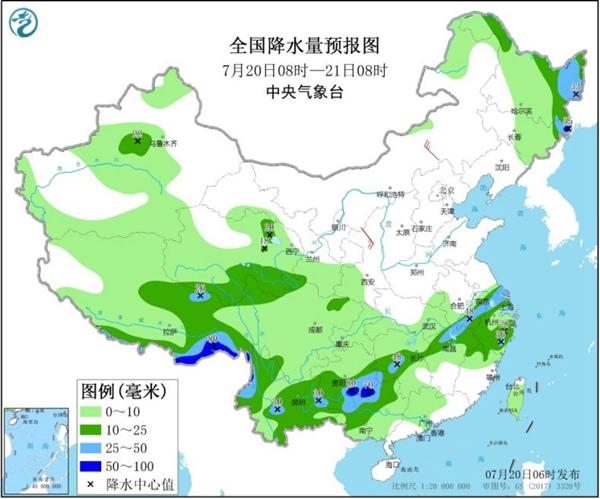China Weather News expects today (20th) that the southern rain will temporarily weaken, mainly from small to moderate rain. In the Ming Dynasty, the main rain belt lifted north to the Huanghuai area, and a new round of heavy rainfall hit again. There are heavy rains or heavy rains in Henan, Shandong, and Shaanxi.
Yesterday, Weihai, Shandong was hit by heavy rainfall, and pedestrians traveled with umbrellas.
Yesterday, heavy rains occurred in southeastern Guizhou, western and northeastern Hunan, southeastern Hubei, northwestern Jiangxi, southern Anhui and central Yunnan, and central and northern Guangxi, Huaihua and Shaoyang in Hunan, Nanchang and Shangrao in Jiangxi, Huangshan and Chizhou in Anhui, and Nanning in Guangxi , Laibin, Guilin and other parts of the region have heavy rains. The maximum hourly rainfall in these areas is 40 mm to 70 mm, and Nanning, Guangxi and other local areas are 80 mm to 120 mm. Heavy rains occurred in central Heilongjiang, central and eastern Jilin, central and eastern Liaoning, Shandong Peninsula, etc., and local heavy rains in Tonghua, Jilin, Dandong, and Dalian.
Today's heavy rainfall in the south has converged significantly. This round of rainfall will also come to an end. In addition, the rain in the northeast will also weaken. The Central Meteorological Observatory predicts that today, there are moderate to heavy rains in parts of eastern and northern Northeast China, eastern and southern Jiangnan, central and southern Guizhou, central and western Guangxi, most of Yunnan, and eastern Qinghai-Tibet Plateau. Among them, northeast Jilin and Guizhou There are heavy rains in the southeast, northwest Guangxi, and southeast Tibet. Inner central and western Inner Mongolia and other places have 4 to 6 winds.
After the heavy rainfall briefly weakened, a new round of heavy rainfall will develop from tomorrow to the 23rd. The rain belt will obviously rise north, and many areas in the Huanghuai area will be hit by heavy rain. Tomorrow, there will be moderate to heavy rain in parts of northern China, central and western Huanghuai, northeastern Jianghuai, western Jianghan, eastern northwest, northeastern southwest, southeastern Tibet, and southern Yunnan, among which central Henan, southern Shaanxi, and eastern Sichuan There are local rainstorms or heavy rainstorms. In parts of central Inner Mongolia, northern Shaanxi, northern Hubei, and Henan, there are 4-6 winds.
On the 22nd, there were moderate to heavy rains in parts of southern China, Huanghuai, western Jianghan, southeastern northwest, eastern southwest, southwest Yunnan, and southeastern Tibet. Among them, central and southern Shandong, central and eastern Henan, and northern Jiangsu , Northern Anhui, northeastern Sichuan and other places have heavy rain or heavy rain. Huanghuai and other places have winds of grade 4 to 6 and above.
The recent heavy rains in the Huaihe River Basin and the upper and middle reaches of the Yangtze River continued, and it is clear that a new round of heavy rainfall will still affect these places, and it is necessary to continue to strengthen prevention. In addition, the Sichuan Basin should pay attention to prevent mountain torrents and geological disasters, and the Huaihe River Basin should especially prevent urban floods, small and medium river floods and other disasters.
In terms of temperature, due to the influence of rain, the temperature in Northeast China has dropped significantly. Today, the highest temperature in many parts of Northeast China will fall below 30°C or even around 25°C, which is much cooler than it was a while ago. Over the next few days, the northwest region will be rainy and the temperature will remain low.
However, for the central and southern Jiangnan and southern China areas under the control of the subtropical high, the "steaming" mode will continue in the next few days. For example, in Fuzhou and Guangzhou, the high temperature is almost "punched", and the minimum temperature is basically at 27 ℃ ~ 28 ℃ Around, the stuffiness can be described as "standby" around the clock, heatstroke can not be relaxed.

